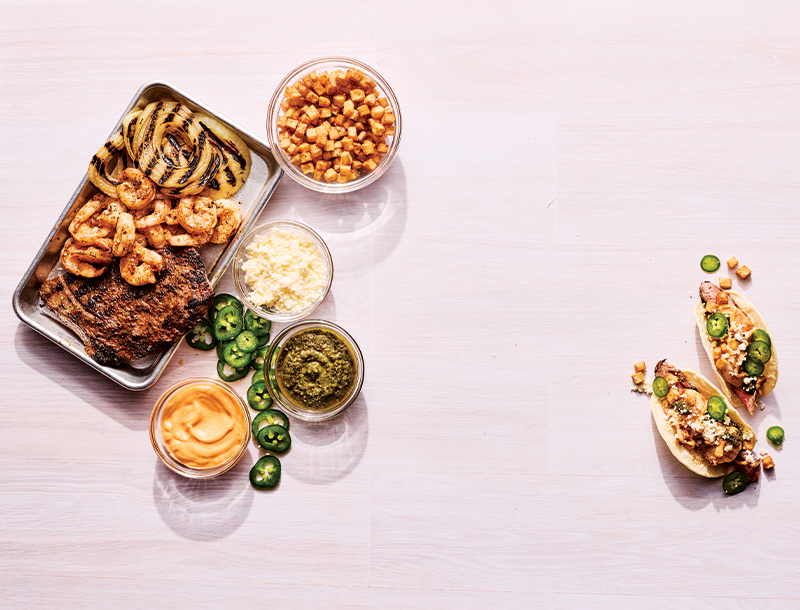From Bytes to Bites: AI Recipes and Culinary Creativity
What you need to know about AI recipe development
About a decade ago, two chefs from the Institute of Culinary Education (ICE) in New York City, Michael Laiskonis and James Briscione, teamed up with IBM Supercomputer Watson. The humans provided the computer with the names of ingredients and types of cuisine and asked it to suggest food combinations.
Recipes from this article:
- Baltic Herring Salad
- Velvet Taco
- Thai Jewish Chicken
 Dishes such as Russian beet salad with yellow tomato, cornichons and prunes, and Cuban lobster bouillabaisse with plantains, butternut squash and jalapeño peppers surfaced, but the chefs still had to do the heavy lifting. They had to select the combinations that looked good and work out the ratios and techniques that would make them taste good.
Dishes such as Russian beet salad with yellow tomato, cornichons and prunes, and Cuban lobster bouillabaisse with plantains, butternut squash and jalapeño peppers surfaced, but the chefs still had to do the heavy lifting. They had to select the combinations that looked good and work out the ratios and techniques that would make them taste good.
ICE published the most notable results in a 2015 cookbook titled, “Cognitive Cooking with Chef Watson: Recipes for Innovation from IBM and the Institute of Culinary Education.”
Can Tech Taste?
AI-assisted recipe apps exist, but ICE hasn’t repeated its experiment. ICE chairman and CEO Rick Smilow said he was unaware of any culinary schools experimenting with the technology, and a representative from The Culinary Institute of America said that the school hasn’t looked to AI for menu development either. But it may be a matter of time. While most chefs say they wouldn’t use AI for developing dishes – arguably the most creative part of the job – in part because technology can’t taste, AI algorithms can analyze the compatibility of ingredients.

“I can see it being useful in chains and larger operations where you have a collection of data over time and it gives you ideas of what to expect (in a particular market),” says Simon Dolinky, director of culinary development support for Kimpton Hotels and Restaurants. “There’s interest in trying AI-created flavor combinations … but there’s always going to be that human touch.”
However, Dolinky sees a role for AI in writing menus. It’s a whiz at translating terms from different languages, quickly finding and explaining the history of a dish or summarizing what’s in a particular item.
“It really shortens the time, but you still have to edit it for your particular use,” he says.
Cuts Research Time
Brandon Frohne, a former chef for Cracker Barrel’s former fast-casual concept Holler & Dash and currently head of the consulting for Frohneats Hospitality, says AI can be a shortcut to replace poring through cookbooks for inspiration. “It can generate industry food trends to consider when developing menu strategy, top-rated restaurants to visit in various cities during the R&D process, generate baseline recipes that can be tweaked to preference during the product development phase, etc.,” he says.
Kimberly R. Litizia, a consultant with management consulting firm Kinetic12, agrees that AI can help with the early development process. “Where I think there is still opportunity is for it to be leveraged with more data integration to be more specific to brand recommendations and social scraping of trends, so it becomes more real-time predictive insights,” she says.
People still need to be involved, however, she added. “(There’s) still a ways to go in my opinion for it to be fully used as a replacement for the human creative mind for full concept development.”
Fills the Gaps
James Walker, chief culinary and concept officer for Experiential Brands, which includes The Original Hot Chicken, Inked Tacos and Pinsa Roman Pizza, added that AI can be a huge money saver by collecting consumer and trend data, but time-consuming and expensive to collect.
He’s also bullish on using it for recipe development, including flavor combinations, textures, colors and naming protocols.
“The data’s out there,” and AI’s expertise is collecting that data and analyzing it. That includes the balance of sweet, salty, sour, bitter and savory flavors, “the structure that you use for flavor development – I think you can put those parameters into the decision-making set (that you feed AI),” he says.
“I think it gives you a great starting point.” But he agrees that AI’s not ready to be let loose in the kitchen.
“Currently, you still need a human to look at the data and make a decision,” he says, and the most important steps of consumer paneling and market testing still require humans to try the food.

